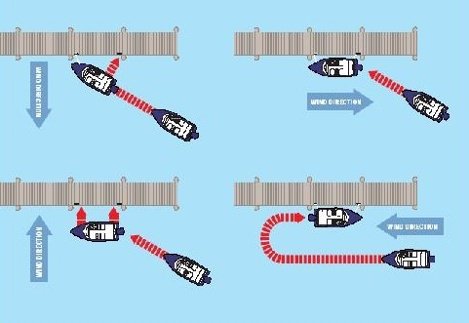Docking a boat involves carefully maneuvering your vessel into a designated space at a marina or dock. Follow these eight steps to dock a boat properly and avoid damage.
There are so many factors to take into consideration (lines, fenders, current, wind, etc.). But the thought of docking should never distract you from having a relaxing cruise with family and friends. This article is here to help by providing step-by-step boat docking basics.
Step 1. Slow Down
Keep your cool when it comes to the marina, especially if it’s crowded. You really need to be patient and take your time here. Coming in too fast is a recipe for disaster - you never want to approach the dock faster than you’re willing to hit it.
Step 2. Be Prepared
As you approach the dock or slip, make sure your crew is prepared and knows exactly what to do to help out. Your lines should be handy and your fenders should be out on the side of the boat where you’ll be tying up. This step will save you from potential damages and embarrassment.
Step 3. Steer Correctly
Always remember that a boat steers from the rear, and it pivots on its axis. This means that when you turn the wheel to the left the back of the boat moves to the right. If you have a single-engine boat, always turn the wheel before applying the power.
Step 4. Use The Right Amount Of Power
You have to remember the docking mantra: “Slow and steady.” This means maintaining an even speed that provides just the right amount of power to get the job done. You may have heard the advice to use shorter bursts of power instead. We don’t recommend this method, as it comes with the danger of accidentally giving it too much power and easily losing control.
Step 5. Be Aware Of The Wind And Current
When docking with wind away from the dock, you must adjust your approach to counteract the force pushing your boat outward. Here’s how to dock in different wind conditions: you need to be aware of how the wind and current are pushing and pulling you, so you can take that into account when trying to position your craft just right.

Step 6. Boat Docking If The Wind Is With You
If the wind is blowing with you, then let it help you. In this scenario, you should come in at a shallow angle. When you are still a yard or two away from the dock, get in a parallel position to it. Then let the wind blow you in effortlessly.
Step 7. Boat Docking If The Wind Is Against You
In this scenario, you need to come in at a steeper angle. This approach will cut down on wind resistance. Your momentum will carry you in close to the dock where you need to be. In this instance, try to secure the bow line first and use the engine to bring the stern of the boat into the dock. Always be ready with dock lines because this kind of wind can easily knock you out of place.
Step 8. Try It Again (If Necessary)
If you didn’t get it just right the first time, no pressure. Even experienced boaters may need a couple of tries before doing it perfectly. If you want to get more docking practice in, take your boat out when there’s not a lot of people around.
TL;DR - Easy Boat Docking Steps
- Slow down and stay patient.
- Prepare your crew with lines and fenders.
- Steer correctly (boats pivot from the rear).
- Use consistent, steady power—not short bursts.
- Adjust for wind and current—let wind assist when possible.
- Secure the boat properly and reposition if needed.
Frequently Asked Questions About Boat Docking Basics
How should you approach the dock when docking your vessel?
You should approach the dock slowly and at a controlled angle, adjusting for wind and current. If docking with no wind, aim for a gradual parallel approach. If docking with wind away from the dock, secure the bow first and use the engine to bring in the stern.
What are the steps for docking with wind away from the dock?
- Approach at a steeper angle to overcome wind resistance.
- Secure the bow line first to prevent drifting.
- Use engine power to gently align the stern to the dock.
- Have dock lines ready in case strong wind pushes the boat away.
What are the steps for docking with wind toward the dock?
- Approach at a shallow angle and let the wind push you in.
- When nearly parallel, reduce power and allow wind pressure to finish docking.
- Secure dock lines quickly to avoid drifting.
With these 8 easy steps and a little practice, you should be able to rest easy with family and friends on your next voyage. Now that you’re prepared to dock your boat, get out there and soak up the sunshine! Need some more advice on the best boat docking supplies? PartsVu is here to help. See PartsVu's broad selection of docking and anchoring products.













1 comment
To begin you need to determine what kind of dock you will likely be building. There are two primary types these are floating dock or free standing dock, the one you choose should depend on what you have deemed more convenient. You will also need to decide on the size of the dock that you will use. For water that has enough depth a shorter dock may be fine. If the area is considerably shallow then a longer deck will be required to allow effective docking of the boat. Basically you will have to first think about functionality above all else.